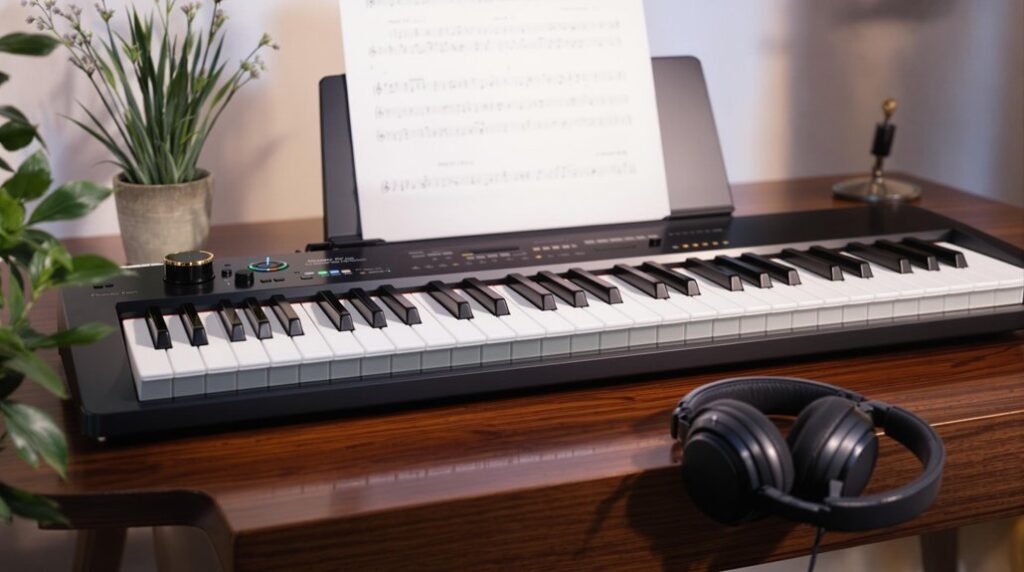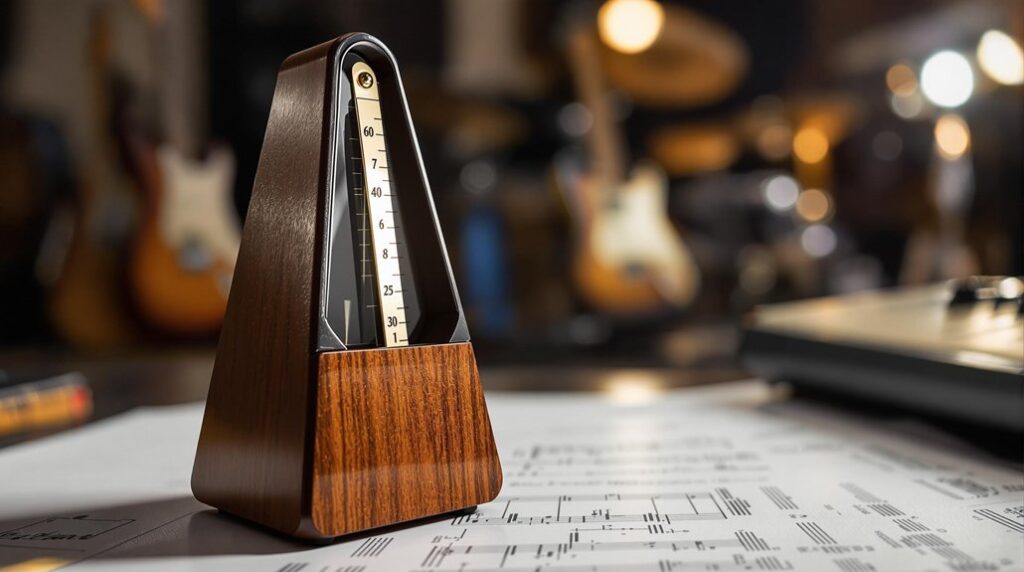Understanding the most common musical notation symbols is fundamental for accurate music interpretation. The staff, comprised of five lines and four spaces, provides the structure for note placement, with the treble and bass clefs indicating specific pitches. Rhythmic values, such as whole, half, and quarter notes, and their corresponding rests, dictate note duration. Time signatures like 4/4 and 6/8 organize rhythmic patterns within measures. Dynamics, including markings like p for piano and f for forte, control volume, while articulation symbols such as staccato and tenuto guide note execution. Accidentals like sharps and flats modify pitch, and key signatures establish a piece’s tonal framework. Continue exploring to uncover the nuanced details of these symbols.
Key Takeaways
- Treble Clef: Indicates the G note above middle C, used for higher-pitched instruments.
- Whole Note: Represents a duration of 4 beats in common time.
- 4/4 Time Signature: Specifies four quarter-note beats per measure.
- Sharp (#): Raises the pitch of a note by a semitone.
- Crescendo: Gradually increases the volume of the music.
Staff and Clefs
The foundation of musical notation lies in the staff and clefs, essential elements that provide the framework for reading and interpreting music. The staff structure consists of five lines and four spaces, each of which corresponds to specific pitches represented by the notes A through G. To identify these pitches accurately, clef types are employed. The two primary clefs are the treble clef and the bass clef.
The treble clef, also known as the G clef, designates the second line of the staff as G above middle C, making it suitable for higher-pitched instruments like the flute and violin. Conversely, the bass clef, or F clef, marks the fourth line as F below middle C, catering to lower-pitched instruments such as the cello and bass guitar.
A brace connects multiple staves for single-instrument notations, such as piano music, while a bracket groups staves of different instruments in an ensemble.
When notes extend beyond the standard range of the five lines and four spaces, ledger lines are used to indicate pitches above or below the staff. These elements collectively guarantee precise and versatile musical notation.
Rhythmic Values
Understanding rhythmic values is vital for interpreting and performing music accurately. Rhythmic values denote the duration of notes and rests in a piece, forming the backbone of rhythmic patterns.
The following table provides a detailed overview of common note durations and their corresponding rests:
| Note/Rhythm Symbol | Duration in 4/4 Time |
|---|---|
| Whole Note (Semibreve) | 4 beats |
| Half Note (Minim) | 2 beats |
| Quarter Note (Crotchet) | 1 beat |
| Eighth Note (Quaver) | 1/2 beat |
| Sixteenth Note (Semiquaver) | 1/4 beat |
In 4/4 time, a whole note (semibreve) is sustained for four beats, while a half note (minim) lasts two beats. Quarter notes (crotchets) are the fundamental units, each occupying one beat. Eighth notes (quavers), often connected by beams for clarity, represent half a beat. Sixteenth notes (semiquavers), with even shorter duration, span a quarter of a beat.
Dotted notes further refine rhythmic values by adding half of the original note’s duration. For instance, a dotted quarter note extends to one and a half beats. Corresponding rests mirror these note values, ensuring silence is appropriately timed, such as a whole rest indicating silence for four beats.
Beaming is essential for organizing eighth notes and shorter durations, aiding in the visual clarity of complex rhythmic patterns. This meticulous structuring of rhythmic values forms the foundation for precise musical execution.
Time Signatures
Time signatures serve as a significant framework for the rhythmic organization of music, dictating the structure of beats within each measure. Notated at the beginning of a piece, time signatures reveal important information: the upper number specifies the beats per measure, while the lower number indicates which note value receives one beat.
For instance, a 4/4 time signature, known as common time, consists of four quarter-note beats per measure. Conversely, cut time (2/2), symbolized by a “C” with a vertical line, assigns two beats per measure, with a half note receiving one beat. These symbols are essential for maintaining rhythmic structure and guiding musicians in interpreting the intended feel of a piece.
The historical evolution of time signatures reflects their adaptability to musical complexity. Early Western music mainly employed simple time signatures, but as compositions became more sophisticated, complex time signatures emerged.
Compound time signatures, such as 6/8, group beats in sets of three, altering the rhythmic feel compared to simple time signatures. In 6/8, the measure contains six eighth notes, resulting in a distinct, flowing rhythm.
Understanding time signatures is essential for performers and composers alike, as these symbols not only define the rhythmic foundation of a piece but also contribute to the overall expressive quality of the music, especially in complex time configurations.
Dynamics
Frequently fundamental to the interpretative depth of a musical performance, dynamics dictate the volume levels at which notes and passages should be executed. These indications, encapsulated in dynamic markings, are essential for achieving dynamic range and expressive dynamics. By following these symbols, musicians can convey a wide array of emotions and intensities, thereby enhancing the overall musical experience.
Significantly, the use of subtractive EQ techniques in audio mixing parallels the role of dynamics in music, both focused on clarity and balanced output.
Common dynamic markings include:
- Piano (p): Indicates a soft volume.
- Forte (f): Suggests a loud volume.
- Mezzo piano (mp) and mezzo forte (mf): Denote moderately soft and moderately loud volumes, respectively.
Dynamic contrast, achieved through variations such as crescendo (cresc.) and decrescendo (decresc.) or diminuendo, plays a vital role in maintaining listener engagement. A crescendo signals a gradual increase in volume, whereas a decrescendo or diminuendo indicates a gradual decrease, allowing performers to shape the musical phrase with nuance.
Additionally, the fermata symbol commands the performer to extend a note’s duration beyond its written value, often contributing to the piece’s dramatic effect. An accent mark, on the other hand, specifies that a note should be played with extra emphasis, thereby highlighting its importance within the musical context.
Collectively, these dynamic tools enable performers to articulate a piece with precise expressive intent.
Articulation Marks
Articulation marks in musical notation greatly influence the expressive execution of a piece by dictating how individual notes should be approached and emphasized.
Common symbols such as staccato, tenuto, fermata, accent, and marcato provide precise instructions for altering note duration, attack, and stress, which in turn shape the overall texture and character of the music.
Common Articulation Symbols
Understanding the nuances of musical expression involves a detailed examination of articulation symbols, which play an essential role in shaping a performance’s character. Among the most common articulation symbols are staccato, tenuto, fermata, accent, and marcato, each contributing uniquely to musical phrasing.
Staccato usage is marked by a dot placed above or below a note, instructing the performer to play the note shorter than its written value, resulting in a crisp, detached sound. This technique is essential for creating rhythmic precision and clarity.
Conversely, tenuto interpretation involves a horizontal line above or below a note, suggesting that the note should be held for its full value or slightly longer to emphasize its importance within the musical context.
The fermata application extends the duration of a note or rest beyond its standard value, as determined by the performer’s discretion, allowing for expressive pauses and dramatic emphasis.
Further, the accent effectiveness is denoted by a sideways V (>) above or below a note, indicating that it should be played with increased emphasis or volume.
The marcato distinction is represented by an accent mark with a vertical line (^), directing the performer to play the note more forcefully than a regular accent, creating a pronounced and impactful effect.
Articulation Symbols Summary:
- Staccato: Short, detached notes.
- Tenuto: Sustained, emphasized notes.
- Fermata: Extended duration notes or rests.
Expressive Performance Techniques
Building on the foundational knowledge of common articulation symbols, the exploration of expressive performance techniques offers deeper insight into how musicians convey emotion and dynamics through nuanced articulation marks.
These expressive tools are essential for achieving sophisticated musical phrasing and emotional expression in performance.
Staccato is indicated by a dot above or below the note, instructing the musician to play the note shorter than its written value, creating a detached, crisp sound. This articulation contributes to the liveliness and rhythmic clarity of a musical passage.
Tenuto, marked by a horizontal line above or below the note, suggests that the note should be held for its full value or slightly longer, thereby emphasizing its significance within the phrase.
A fermata, represented by a dot beneath a curved line, instructs the performer to hold the note longer than its written duration at their discretion, adding a dramatic pause and enhancing emotional depth.
An accent, denoted by a sideways V, indicates increased volume or a stronger attack on the note, thereby highlighting it within the musical texture.
Marcato, a more forceful articulation than a regular accent, is indicated by a vertical wedge symbol and requires the note to be played with greater emphasis, enhancing its rhythmic prominence and dynamic impact within the musical context.
Accidentals and Key Signatures
Accidentals, including flats (♭), sharps (♯), and naturals (♮), are essential for altering the pitch of individual notes within a measure, with double flats (♭♭) and double sharps (♯♯) extending this modification to two semitones.
In contrast, key signatures, positioned at the beginning of a composition, systematically designate which notes are consistently played as sharps or flats, thereby defining the tonal center and overall key.
The interaction between accidentals and key signatures is fundamental in establishing the harmonic and melodic structure of a piece, distinguishing between major and minor scales.
Types of Accidentals
In musical notation, accidentals play a fundamental role in defining the precise pitch of notes within a measure. They are essential for modifying the natural pitch of notes to fit the harmonic and melodic requirements of a composition. The standard accidentals include sharps (♯), flats (♭), and naturals (♮). These symbols, when placed before a note, alter its pitch and remain effective for the duration of the measure unless cancelled by another accidental.
Types of Accidentals
- Sharp (♯): This accidental notation raises the pitch of a note by one semitone. It is often used to create tension or to modulate to a different key.
- Flat (♭): Conversely, this symbol lowers the pitch of a note by one semitone. Flats are commonly employed in creating smooth, flowing melodies.
- Enhanced Accidentals: These include double sharps (♯♯) and double flats (♭♭), which raise or lower the pitch by two semitones, respectively. Enhanced accidentals are vital for achieving precise pitch alterations in complex pieces.
A natural (♮) is employed to cancel any previous sharps or flats, guaranteeing the note returns to its original pitch. Such meticulous use of accidentals guarantees the accurate representation of a composer’s intended sound within a piece.
Role of Key Signatures
Key signatures are integral to the structure and interpretation of musical compositions, as they establish the fundamental tonal center and dictate the specific pitches consistently altered throughout a piece. Positioned at the beginning of a staff, key signatures indicate which notes are consistently sharp or flat, thereby defining the tonal center and facilitating the identification of major and minor scales. For instance, a key signature with no sharps or flats corresponds to C major or A minor, while each additional sharp or flat corresponds to a specific key, elucidating key relationships.
Understanding key signatures is paramount for musicians, as they determine the pitch alteration of notes. Sharps raise the pitch of the corresponding notes by a semitone, while flats lower them by the same interval, ensuring that the integrity of the musical context is maintained throughout the piece.
Accidentals, such as additional sharps, flats, or naturals within a measure, provide temporary pitch modifications that override the key signature until the measure’s end.
The mastery of key signatures enables performers to navigate the required fingerings and tonalities specific to their instruments, ensuring accurate interpretation and performance. Consequently, key signatures are foundational elements that underpin the harmonic and melodic structure of musical compositions.
Frequently Asked Questions
What Is the Most Popular Music Symbol?
The treble clef, also known as the G clef, is widely considered the most popular music symbol, primarily due to its extensive use in notating higher-pitched instruments and voices, contrasting with the bass clef for lower registers.
What Are the 5 Lines Musical Notation?
The five lines of the musical staff, known as staff lines, are fundamental components in musical notation. Each line and space correspond to specific pitches, thereby enabling precise representation of musical notes and facilitating accurate performance interpretation.
What Is Common Notation in Music?
Common notation in music is a standardized system that employs symbols to convey musical dynamics, rhythmic patterns, pitch, and articulation. This system guarantees accurate interpretation and performance, facilitating communication between composers and musicians.
What Are the Names of the Main Musical Notations in English?
The main musical notations in English include clefs types such as the G clef (treble) and F clef (bass), and note values including whole notes, half notes, quarter notes, and eighth notes, each defining specific pitch and duration.
Conclusion
To summarize, musical notation is a complex but systematic method for representing sound through symbols. Understanding the staff and clefs, rhythmic values, time signatures, dynamics, articulation marks, accidentals, and key signatures is essential for interpreting and performing music accurately. Each symbol conveys specific instructions to musicians, ensuring precise execution of a composer’s intent. Mastery of these elements allows for a deeper appreciation and more accurate rendition of musical works across various genres and styles.




